Venice the spider in the web between Byzantine, Ottoman and Habsburg empire
As everybody knows, Venice is a town governed by water but dominating the sea. Ideally, any visitor therefore should arrive in a boat from the Adriatic. His first impression then would be the magnificent view of the skyline along the water front, the Palazzo Ducale at the Piazza San Marco with its campanile, the Church of San Giorgio Maggiore across the channel and in between the punta de la Dogana, where the ancient merchant ships were taxed by the officials of the serenissima after arrival.
Until recently several cruise ships daily passed through Venice and the passengers from their decks had exactly that first view of the city. Afterwards they disembarked at a brand new cruise terminal built for that purpose at the land side of town. Thousands of them would board a mono-rail and then flood the narrow alleys of the old town.
Visiting Venice by cruise ship is past time. The behemoths, which were far higher than the highest domes and campaniles of impressive San Giorgio Maggiore or Santa Maria della Salute, are not allowed to enter the town and sail through the Giudecca Canal any more. They now have to dock in far away Trieste or Rimini. The only remaining way to still arrive from the Adriatic are the car ferries linking Venice to different ports along the Croatian and Greek coast.
Punta de la Dogana, the entrance to the Canal Grande and former Customs station of the Serenissima, on top two statues of Atlas holding a golden globe whith the figure of Fortune
When you touch down at the airport one of the yellow Alilaguna vaporettos will first present you the backyard of the town. However, when you arrive by train and you leave the station of Santa Lucia you immediately stand at the edge of what must be one of the world’s busiest, and most chaotic waterways, the Canal Grande. Although the palaces surrounding the Chiesa di San Simeon Piccolo and Santa Maria di Nazareth close to the station are far less impressive than those a bit further down the canal the arriving train passenger nevertheless is welcomed by a scene which he will see nowhere else.
"In 1867 Mark Twain also arrived in Venice by train: … but hurry straight to the ancient city of the sea, the widowed bride of the Adriatic. It was a long, long ride. But toward evening, as we sat silent and hardly conscious of where we were--subdued into that meditative calm that comes so surely after a conversational storm--some one shouted--
“VENICE!”
And sure enough, afloat on the placid sea a league away, lay a great city, with its towers and domes and steeples drowsing in a golden mist of sunset" (The innocents abroad)
The bedlam of Vaporettos, freight barges, taxi and pleasure boats makes you wonder how the hand operated gondolas can survive in between. The muddy water of the canal is churning. Horns or sirens rival for attention.
It is too far to walk to the hotel I have booked on the Zattere. I have to take the vaporetto. There are four different stops and I try to find out which line to use and which ticket to buy. Next to the ticket machines there are also several counters. They all have a long queue while nobody is waiting at the machines. And those machines are also multilingual. I wait in the queue and buy a ticket for a whole week. If I do not use all the days I can give it to somebody else.
Vaporetto stop
Did they ever renew those vaporettos? I cannot remember that they ever looked different. The noisy boats look worn out and the cumbersome operation involving docking them to the jetty with a rope looks outdated and dangerous. Remember that they warn every train passenger to mind a gap of 5 cm. Here the gap is wobbling and wide and while you try to board or leave the boat is tossed around on the turbulent water of the canal. The attendants are helpful but dislike people with backpacks. But if I take it off I neither have a free hand nor do I consume less space. And the vaporetto is packed.
In the time of Mark Twain the arriving visitors were shipped by gondola to their hotels: ”We reached Venice at eight in the evening, and entered a hearse belonging to the Grand Hotel d’Europe. At any rate, it was more like a hearse than any thing else, though to speak by the card, it was a gondola.” (The innocents abroad)
Most of the people on the vaporettos are tourists. As compared to 49000 inhabitants actually living in Venice there are 70.000 daily visitors, 28 million every year. To regulate the masses and earn a bit of money for the immense costs of maintaining the historic monuments the city started an experiment of charging an entrance fee for day visitors. However, the fee is only charged on certain weekends. The ticket machines and an information rest dormant on the square in front of the station. If you stay overnight you don’t have to pay.
Venice is in a struggle to avoid being taken over by the tourists. Signs remind visitors of decent behavior. At the most popular tourist sites stewards watch out for improper behavior and shoo away visitors who have spread out on stairs or pedestals of monuments. Improper clothing is off-limits in churches, monasteries and some musea. On the other hand, what could a city do which has lost most if its inhabitants and has to resort to tourism as last means of income.
Venice arose from the fear of the invading Barbarians from the north and east. In 476 AD Odoaker, a Germanic warrior in Roman services, had conquered the Western Roman empire and had declared himself king of Italy. This did not please the Eastern Roman emperors in Constantinople who shook hands with the Ostrogoth king Theoderic to get rid of him and consequently murdered him 17 years later. Barbarians ruling over barbaric tribes. Italy was in turmoil. However, the lagoon was fairly save.
The medieval venetian covered market is still in use
The byzantine emperor Justinian tried to make an end to the chaos. In 532 his general Narses conquered the lagoon which at that time already had a reputation as a center for naval trade. While the chaos in Italy continued with another wave of conquest and immigration by the Langobards and the Mediterranean was terrorized by the expansion of the belligerent Islam the cities in the lagune thrived and became prosperous.
By the 7th century the territory of the eastern roman empire in the northern Adriatic was reduced to Venice, Ravenna and Istria. Constantinople was barely able to protect their far away Italian possessions. So in 697 AD the settlements in the Lagoon took things into their own hands and voted a Doge as their leader. When Charlemagne tried to conquer Italy around 800 the fleet of the lagune already was more powerful than the one of Constantinople. While Charlemagne was able to conquer most of the lagoon, the inhabitants retreated to Riva Alta, the present location of Venice, which then still was an assembly of mudflats and swamps. A town representing the power of the young naval merchant nation had to be built. The construction of the Ducal palace and a cathedral began. Their architecture reflected the close bands to the Byzantine empire.
“One lingers about the Cathedral a good deal, in Venice. There is a strong fascination about it—partly because it is so old, and partly because it is so ugly….. it seemed like a vast warty bug taking a meditative walk” (Mark Twain, A tramp abroad)
At that time a church needed a saint. Saints bequeathed relics. The Venetians discovered the remainders of the Apostle Marc in a monastery in Alexandria. It was smuggled onto a Venetian ship in a basket covered with pork, a treat not particularly popular with the Muslim custom guards.
San Marco square
The construction of the church revealed another specialty of the Venetians. They were accomplished robbers. Columns and pieces of art were stolen from sites allover the Mediterranean to decorate the church.
View of the Ducal palace
Meanwhile Venice had got rid of the supremacy of Constantinople. The Venetian territory in the Mediterranean increased on the expense of the Byzantine empire. And while keeping a trading mission in Galata across the Golden Horn from Constantinople the lagune empire also traded with the other archenemies of the Byzantines, the Muslims. It also managed to be neutral in the struggle between the German emperors and the pope. Trading with everybody brought more profit than war. And the profit was invested in gorgeous buildings and art in the capital.
Bridge of Sighs (Ponte dei Sospiri) to the dungeons of the Ducal palace
The final score with Byzanz was settled in 1204. For the transport of the knights of the 4th crusade the brave christian army needed ships. The only power having the necessary navy were the Venetians. However, the Crusaders did not have the funds to pay for their transport. In exchange, the Venetians proposed to help the disposed former Byzantine emperor Isaac II Angelus back into power and conquer Constantinople (part 16). Back in power, Isaac would pay the Venetians for the use of their ships. However, after he did not keep his promise the crusaders sacked the town, sent the booty back to where they came from and installed themselves as Byzantine rulers. The old and blind Doge Enrico Dandolo declared himself the “Leader and despot of a quarter and half a quarter of the Roman empire”. He died and is buried in Byzanz.
One of the most remarkable pieces of booty the Venetians brought home from Constantinople was the Quadriga that decorated the hippodrome. It was mounted above the entrance of the church of St. Marc where it still resides.
The gate to San Marco square with the winged Venetian lion
“We have seen the ancient pride of Venice, the grim Bronze Horses that figure in a thousand legends. Venice may well cherish them, for they are the only horses she ever had. It is said there are hundreds of people in this curious city who never have seen a living horse in their lives. It is entirely true, no doubt” (Mark Twain, The innocents abroad).
The Venetians provided 480 ships for the crusade. The construction and maintenance of such a big fleet needed a shipyard. The Arsenale, the original Venetian shipyard still covers a large area in the east of the main island. As such it forms one of the earliest examples of a large industrial complex before the industrial revolution. Parts of it are still used by the Italian navy.
Pedestrian entrance to the Arsenale, the lions were stolen from the Acropolis in Athens
The entire area was surrounded by fortifications and high walls. A gate decorated with the winged Venetian lion gave access to the interior. The lions on guard next to the entrance were stolen in Athens. Inside, reminders of its former function are abundant. There a numerous brick warehouses and sheds covered with wooden roofs. Two historic dry docks lined with Istrian marble, the pumphouse and modern cranes show that the area was still used long after the disappearance of the Venetian republic. Next to some modern cranes the Arsenale also preserves an Armstrong Mitchell hydraulic crane from 1883, the last of its kind still in existence.
Armstrong Mitchell hydraulic crane
Just outside the Arsenal, close to the dry docks, Klaus Littmann has installed his “arena for a tree”. A huge wooden bowl houses benches surrounding a tree as the main actor in a silent theater. At the same time the tree reminds of the material used for the thousands of ships built on these grounds.
The other, smaller dry dock, serves as base for the monumental sculpture “Building Bridges” by Lorenzo Quinn.
The shipbuilding process was highly standardized. At its height the Arsenale employed 16.000 workers and was able to produce nearly one ship a day.
Docks in the Arsenale
Most of the Arsenal was destroyed after the occupation of Venice by Napoleon. It was later rebuilt for the purposes of the modern Italian Navy. Maps in the Museo Storico Navale di Venezia show how the Arsenal looked like at the end of the 18th century, shortly before Napoleon’s arrival. Unfortunately the museum is unable to present even an overview of the marine activities of the Venetian empire. It is content with a collection of models of ships, a few pictures of fortifications and a couple of plans. It is a pity. There would be so many stories to tell. They should take a example of the museo naval de Caribe in Cartagena, Colombia, which is exactly the place where history comes to life.
Until recently the area of the arsenal was closed to visitors. Meanwhile, repurposing is on the way. The arsenal now is used as exhibition space during the Biennale arts exhibition. A visit to the exhibition also gives the opportunity to visit big parts of the arsenal, the old warehouses, cranes and other forgotten relics. With the contrast to the modern art the old buildings become even more iconic.
This year’s title of the Biennale is “Foreigners everywhere”. In a town which has sent its ships allover the Mediterranean, has sent troops to fight wars far from home, has imprisoned people, brought them back as slaves or condemned them to spend their remaining miserable lifes on the rows of a galley, has welcomed merchants and artists from allover Europe for many century and now is struggling with a wave of tourists from allover the world this title seems to be highly appropriate.
Inside the docks
“The guide I have spoken of is the only one we have had yet who knew any thing. He was born in South Carolina, of slave parents. They came to Venice while he was an infant. He has grown up here. He is well educated. He reads, writes, and speaks English, Italian, Spanish, and French, with perfect facility; is a worshipper of art and thoroughly conversant with it; knows the history of Venice by heart and never tires of talking of her illustrious career. He dresses better than any of us, I think, and is daintily polite. Negroes are deemed as good as white people, in Venice, and so this man feels no desire to go back to his native land. His judgment is correct”. (Mark Twain, The innocents abroad)
Brett Graham’s “Wastelands”
After entering, one of the first sculptures confronting the visitor is Brett Graham’s “Wastelands”. A huge black cart symbolizing the need for mobility and transition stretches out its arm-like handle bars as if in an outcry for help towards the spectator.
One of the most meaningful works of art in this exhibition is Bouchra Khalili’s “Mapping journeys”. Several screens show videos where refugees document their odyssey in search of a new future in Europe with a felt pen on a map.
One aspect of the Biennale is that the visitor is confronted with art from countries which are normally not on the list of exhibits in western galleries. At the same time it is remarkable to see the contribution of Muslim countries in a city which, for centuries, formed one of the bastions of resistance against the further expansion of Islam.
The contribution of Saudi Arabia is Manal Aldowayan’s “Shifting sands, a Battle Song” brings, according to the comments “together the sonic and geological features of the desert with the voices and energy of Saudi women during a period of profound cultural transformation”. For me it is already revolutionary that the Saudis choose the work of a female artist for their contribution.
The contribution of the United Arab Emirates “Sites of memory, sites of amnesia” by Abdullah al saadi” creates an own unique world. Visitors are invited to discover both the displayed art pieces and others hidden in metal chests.
“Everything Precious Is Fragile”
For the first time Benin displays a national pavillion on the Biennale. “Everything Precious Is Fragile” is the title. The vote is a huge domed hut built from discarded jerry cans. However, The exposition also includes a library on colonial legacy, indigenous knowledge and biodiversity loss.
For centuries the Venetian Republic was one of the players in the struggle of power in the eastern Mediterranean and the Balkan coast. After the 4th crusade the Byzantine empire never recovered. The schisma in the Christian church implied that the orthodox church was regarded as an enemy. The pleas of the last Byzantine emperors Manuel II and Johannes VIII for help against the encroaching Turks did not bear any results. The Venetians might have regretted their passivity. After the conquest of Constantinople the Turks formed a much more formidable enemy for the Venetian ships and their trade in the Eastern Mediterranean. Muslim pirates operating from the Northern African coast made shipping dangerous in the southern and western Mediterranean.
The vanishing influence of the Byzantine empire also had its impact on the building style. The Byzantine architectural style was abandoned and palaces like the Ca d’Oro or the Palazzo Pesaro Orfei and of course the Ducal palace and churches like Santi Giovanni e Paolo were now built in Venetian Gothic style. The gothic Basilica S.Maria Gloriosa dei Frari is the biggest church of Venice and its campanile is second only to the one on San Marco Square. While the campanile was finished in 1396 it took more than 100 years to finish the church which was consecrated in 1492.
The interior of the church houses the graves of the Doges Tron, Pesaro, Foscari and Francesco Dandolo but also the monument to the mercenary commander Paolo Savelli, one of the few of its type on a horse.
John the baptist of Donatello
The statue of John the baptist of Donatello is from 1438, from the time of the construction of the church.
The church also displays Titian’s painting of the Pesaro madonna from 1519-1526 and the presentation of Jesus Christ in the temple from 1550-1560 of Giuseppe Porta called Salviati
Much later a monument to Canova was installed in 1822-1827 and to Tizian in 1852.
Monument to Tizian
”Among a long list of churches, art galleries, and such things, visited by us in Venice, I shall mention only one--the church of Santa Maria dei Frari. It is about five hundred years old, I believe, and stands on twelve hundred thousand piles. In it lie the body of Canova and the heart of Titian, under magnificent monuments. Titian died at the age of almost one hundred years. A plague which swept away fifty thousand lives was raging at the time, and there is notable evidence of the reverence in which the great painter was held, in the fact that to him alone the state permitted a public funeral in all that season of terror and death.” (Mark Twain, The innocents abroad”)
The church of Santa Maria dei Frari has a cloister, but during all my visits so far it was closed. Thanks to the Biennale the cloister of Santa Maria de Visitatione on the Zattere is open.
San Stephano
Another well preserved gothic church is San Stephano. Under its roof in the shape of an overturned hull of a ship it houses the graves of Doges Andrea Contarini (died 1382) and Francesco Morosini (died 1694). Next to it is the former convent. A door of the grand cloister happens to be open when I pass by. It is empty, abandoned. Another great space to house a museum, a hotel or … a monastery.
The canal under San Stephano
The leaning campanile of San Stephano
San Stephano is also the last church which actually bridges a canal. You can pass under the nave in a boat. Its campanile is leaning in an alarming degree. Supports already have been placed.
Venice is divided into six districts called Sestieri in Italian: Cannaregio, Santa Croce, San Polo, Dorsoduro, Castello and San Marco. Originally each neighborhood was built around a church. There are only 3 canals, next to the Canale Grande those of Canareggio and Giudecca. The other waterways are called Rio. Next to the gondolas only motorboats are allowed on the canals. No canoes and no swimming. With the heat of July, when your shirt is already drenched with sweat as soon as you leave the hotel, especially the latter is hard to bear.
Rules for tourists
Visitors to Venice staying overnight covet a room with the view of a canal, preferably right above the water. They forget that the canals are the highways of Venice. In the morning the garbage and provisioning boats arrive with considerable noise. At night, like their colleagues on the road, pleasure boats pass by at high speed playing hard music. Most of the rooms do not have mosquito nets. But in a city built in a swamp there are loads of mosquitos. Particularly in summer when you want to open the windows it is not wise to do so.
And of course the hotel should be in a palazzo. Yet only the most expensive hotels in palazzos have modern facilities like a lift. Many still have shared bathrooms and you can be glad if you find a spare socket in your room. In the morning the footprints of the previous day remain on the floor of the shared bathroom and the carcass of a slug decorates the only chair.
If you don’t have a boat in Venice or exclusive transport in a gondola like Mark Twain had you have to walk. Venice has only one Piazza, San Marco. The other squares are called Campo. The streets are called Calle or Fondamento. Walking the streets at night was dangerous. Robbers and muggers waited in dark corners. Street lanterns were only introduced around 1700. At sunset they were lit by lanternmen called codega. To prevent criminals from hiding in the dark corners they were filled with sloping brickwork. House numbers were only introduced under the short rule of Napoleon begin of the 19th century but they are distributed haphazardly. When they took over, the Austrians finally introduced street names to find their way.
After the 13th century horses were forbidden in the streets of the city. Modern extensions to the ban include bicycles and scooters. With some of the narrow alleys choked with visitors and the bridges involving stairs this makes sense.
For the nobles of historic Venice the gondolas served for daily traffic. With one exception they are only used by tourists today. The exception is the gondola ferry service which allows pedestrians to cross the canal Grande at half a dozen spots. One of the last private owners using her gondola was Peggy Guggenheim. After 40 years of use it is displayed in the Naval Museum.
Gondola shipyard, the Squero di San Trovaso
In the sestiere Dorsoduro one shipyard, the Squero di San Trovaso, still builds and repairs gondolas. Each is composed of 280 pieces of wood. It is not cheap to become a gondoliere. Buying a gondola sets you back 40.000 €. Another 200.000 € you will have to put down for a license, if you get one.
“This the famed gondola and this the gorgeous gondolier!--the one an inky, rusty old canoe with a sable hearse-body clapped on to the middle of it, and the other a mangy, barefooted guttersnipe with a portion of his raiment on exhibition which should have been sacred from public scrutiny” (Mark Twain, the innocents abroad)
Venice has around 400 bridges. 300 are from stone. Only 4 bridges cross the Canal Grande. The oldest is of course the Rialto bridge from 1591. It replaced previous wooden bridges which kept collapsing. Every year it is crossed by the astounding amount of 44 million pedestrians. Next to the station is the Ponte de Scalzi. The Ponte de Accademia originally was a steel bridge constructed as a temporary solution in 1854. Later it was replaced by the current wooden bridge. The temporary solution became permanent. The latest addition is Ponte de Constitutione linking the railway station and the car parks and bus station at Piazzale Roma. It was designed by the Spanish star architect Calatrava. Part of the stairs were paved with glass. Even before the inauguration in 2008 the project was controversial. Since there was no handicapped access a lift had to be fitted retroactively at enormous costs. It was a failure and had to be dismantled at more costs. The glass surface caused people to slip and fall, resulting in injuries. Meanwhile it is decided to replace the glass by a less slippery material.
The culmination of Venetian power was reflected by the battle of Lepanto in 1571, the last big naval battle which mainly involved galleys. The Ottoman navy with 222 galleys and 56 galliots manned with 37000 sailors and 30000 soldiers met an armada of the Holy League with 206 galleys and 6 galleasses manned with 30000 sailors and 35000 soldiers near the Greek town of Lepanto. 109 galleys and the galleasses were provided by the Venetian Republic. Their victory halted the advance of the Ottoman empire in the Adriatic.
The naval museum of Venice has very few models of galley. This is actually the galley of the grandmaster of the Maltese knights
Meanwhile the townsfolk indulged in pleasure and luxury. Up to 13000 prostitutes found their employment in the dark alleys. Carnival became a way of life and reigned year round. Everybody including priest and doge carried masks to conduct their business “incognito”. By wearing a mask the commoner could appear as a nobleman and the paria could say and do what he wanted without consequences. Around 100 casinos competed for the gold of the players. The peepholes from where visitors could be inspected still disclose their former location in some buildings.
However, the hourglass counting the days of the republic was running low. Shifting trade routes reduced the profit. In Italy, several competing city states had built rival ports like Livorno, Genova or Ancona. The Venetian supremacy in the Adriatic was broken when the Habsburg empire got their own seaport in Trieste. At the same time conflicts over Greece, the Dalmatian coast and Aegean islands were ongoing with the Turks. The debt of the Republic increased. In 1792 the once great Venetian merchant fleet employed not more than 309 merchants.
When at the end of the 18th century the threat of Napoleon arose to the west of the Venetian mainland possessions the Republic was barely able to defend herself. By 1796 the navy had only 13 ships of the line left, most out of service. The army was reduced to some battalions of mercenaries.
After 1100 years, on May 12th, 1797, the Venetian Republic finally fell. The last doge, Ludovico Manin, abdicated and retreated to his private residence outside Venice. Rumor has it that he took off the “corno ducale”, the strange hat worn by the doges, with the words “I don’t need that anymore”.
The French thoroughly plundered the city. The Quadriga, which had been stolen by the Venetians 600 years earlier in Byzanz, was now stolen and brought to Paris. However, in the secret contract of Leoben of April 1797 the French and the Austrians had agreed that Austria would receive Venice in exchange for the Austrian Netherlands. The agreement was confirmed by a vote of the population. They voted for Austria since the French continued looting. Before they finally disappeared they annihilated the entire Venetian Navy and destroyed much of the Arsenal. However, at that time the remaining naval power had been reduced to a mere handful of ships.
After another French occupation between 1805 and 1815 Venice and the former Venetian territory in Northern Italy and Dalmatia finally came under Austrian rule.
“She that in her palmy days commanded the commerce of a hemisphere and made the weal or woe of nations with a beck of her puissant finger, is become the humblest among the peoples of the earth,--a peddler of glass beads for women, and trifling toys and trinkets for school-girls and children”. (Mark Twain, the innocents abroad)
Soon after the Napoleonic wars the city in the Lagune, now under Austrian rule, became a destination for tourists. Rich young people found it fashionable to conduct a grand tour of Europe and Venice was one of the destinations. The "rich and famous" often stayed and dined at luxury establishments such as the Danieli Hotel and the Caffè Florian.
One of the first was Lord Byron in 1816-1819. Many others like Henry James, Ezra Pound, Thomas Mann, Franz Kafka, Cole Porter, Alice Cooper or Beyoncé followed. Mark Twain visited several times. Artists became famous for their interpretation of views of Venice. One was Willem Dekoning who is honored by a temporary exhibition in the Accademia. Celebrities started buying palaces. Peggy Guggenheim bought a palace along the Canal Grande for establishing an art gallery and lived in Venice between 1949 and her death 1979. There is narrow margin between eccentricity and craziness. The behavior of many of those new and rich residents of Venice were not far from the one of those several hundred years before. Today even a ruin like this one will cost you 4.5 million €.
Some were not very happy with their property. In particular Ca Dario was regarded a haunted palace. Built in 1486 in Venetian Gothic style on top of a Templar cemetery it was commissioned by Giovanni Dario who was considered a hero in Venice at the time. He died before the palace was finished and it passed on to his daughter Marietta. Soon her husband was stabbed and her son was killed in Crete in an ambush. Marietta committed suicide. In the 19th century it was bought by Arbit Abdoll, an Armenian diamond merchant who died poor after bankruptcy. In 1901 a French couple bought it and committed suicide. Mario de Monaco wanted to buy it in 1964 but had to give up the plan because he had a serious car accident. In the 1970’ies it was purchased by Christopher "Kit" Lambert, manager of The Who who suffered a financial crisis aggravated by the use of drugs. He decided to sell it to Fabrizio Ferrari, a Venetian businessman, who moved in with his sister. The latter soon died in a strange car accident while he became bankrupt and was arrested. The financier Raul Gardini bought the building in the late 80s and committed suicide in 1993. In 2002 John Entwistle, bassist of The Who, regardless of his mate’s fate, rented the Palazzo for a holiday in Venice but died a week after returning. In 2006 the property passed to an American company for 9 million. Nobody was ever seen there. Woody Allen wanted to buy it in the 1990’ies but did not and is still alive.
Entrance to Ca Dario
“What a funny old city this Queen of the Adriatic is! Narrow streets, vast, gloomy marble palaces, black with the corroding damps of centuries, and all partly submerged; no dry land visible any where, and no sidewalks worth mentioning; if you want to go to church, to the theatre, or to the restaurant, you must call a gondola. It must be a paradise for cripples, for verily a man has no use for legs here”. (Mark Twain, The innocents abroad)
Another remarkable of the many remarkable palaces is the Palazzo Contarini de Bovolo. It was built in 1499. Although there is an interior staircase another spectacular exterior one was added in the style of the famous tower of Pisa. It gives access to a Loggia with a sweeping view of the roofs of Venice.
Sale of fruit and vegetable from a boat
When the former territory of the Republic of Venice including the city passed into the possession of the Habsburg empire in 1815 the kingdom of Lombardy Venetia was formed. It was ruled by emperor Francis I until 1835 and then Ferdinand I until 1848. The actual ruler was a Vice-roi. Most of them were members of the Habsburtg family, but from 1848 until 1857 it was Joseph Radetzky von Radetz, the famous Austrian field marshal. The new Austrian acquisitions (which also included the Grand Duchy of Tuscany, the Duchy of Modena and Reggio as well as the Duchy of Parma) very quickly faced the opposition of the rising Italian movement of independence and unification, the risorgimento. Already in 1848 during the Europe wide revolution the movement initially conquered Milan and Venice but was immediately suppressed by the nomination of Radetzky.
One of the protagonists of the Venetian movement for independence from Austria was Daniele Manin. Manin had led the Venetians during the revolution of 1848 which led to a temporary expulsion of the Austrian forces from the city. Eventually the uprising failed. Manin did not live long enough to witness the final withdrawal of the Austrian forces and the inclusion of Venice into Italy but died in exile in Paris in 1857.
In 1859 Austria was defeated in the battle of Solferino in the Second Italian War of Independence. Most of Austria’s Northern Italian territory was included into the nascent Italian state. Once more Venice became a capita, now of the remaining Austrian lands in Italy. But the lagune’s new leading role was very short. After the Third Italian War of Independence and the result of a plebiscite Venetia finally became part of the unified Italian state.
“We have seen the Campanile, and Byron’s house and Balbi’s the geographer, and the palaces of all the ancient dukes and doges of Venice, and we have seen their effeminate descendants airing their nobility in fashionable French attire in the Grand Square of St. Mark, and eating ices and drinking cheap wines, instead of wearing gallant coats of mail and destroying fleets and armies as their great ancestors did in the days of Venetian glory. (Mark Twain, The innocents abroad)
Most of Venice around the Canal Grande is an urban island of stone. During the rule of Napoleon Bonaparte the marshland to the east of the sea of stone was drained and turned into gardens. A city so full of monuments and art seemed to be the right place for a regular art festival. Since 1895 the Biennale art exhibition takes place in the summer month. The gardens of the Giardini were chosen as location.
To start with, a central pavilion was built. After 1807 national pavilions were added for selected participating nations. Now the gardens contain 30 permanent national pavilions where works of artist(s) selected to represent the nation are exhibited every second year. Some of the pavilions are the creation of famous architects. The Austrian Pavilion was designed by Josef Hoffmann, the Dutch pavilion by Gerrit Rietveld and the Finnish pavilion by Alvar Aalto. My favorite is the Hungarian pavilion, an art deco jewel designed as one of the first by Géza Rintel in 1909. The link to the website of the Biennale gives information to the architect and year of construction of all the pavilions.
This years contribution in the Hungarian pavilion by Márton Nemes.
One of this year’s works presented in the Austrian pavilion is “Research for Sleeping Positions” by Jermolaewa. In a video of 18 min the artist has documented her attempts to find a suitable position on a train station bench at Vienna's Westbahnhof which has been made unsuitable for sleeping. Seventeen years earlier she had arrived in Austria as a political refugee and spent her first week on a bench in this station.
For comparison I have added a photo of a bench in a park in the Romanian town of Turnu Severini. A homeless has spread out his bedding on a bench and it stays there untouched during the day until he comes back for his night’s rest.
Under the direction of artist Renzo Martens the Dutch pavilion was transferred to the Cercle d'Art des Travailleurs de Plantation Congolaise (CATPC), for their international celebration of blasphemy and the sacred.
The architecture of the pavilion of the United States of America is a typical copy of the style of neoclassical government buildings in Washington, DC. This year it houses the colorful exhibition of native american artist Jeffrey Gibson, “the space in which to place me”.
Jeffrey Gibson, “the space in which to place me”.
The idea of Koo Jeong A is to blur “the lines between their artwork and the space it occupies”. The installation Odorama Cities in the Korean pavilion is part of the idea a making a scent portrait of the Korean peninsula.
There is a warning sign at the entrance to the Japanese Pavilion. There might be irritation by mold and fungus. The exhibition “Decomposition” by Yuko Mohri generates sounds and light by inserting electrodes into decomposing fruits and converting their moisture into electric signals.
Korean pavilion
The German Pavilion designed in 1938 by Ernst Haiger replaced a previous building from 1912. Haiger became a party member even before Hitler came to power in 1932. He design a number of minor buildings like in 1937 the Officer's Mess in the “Führer Building“ at Königsplatz in Munich and in 1938 the bar and pub in the “Haus der Kunst“. The pavilion was inaugurated by the Nazi government. This year’s presentation goes beyond the Pavilion and includes the practically empty island La Certosa on the vaporetto from the Giardini to the cemetery and Murano. In the Pavilion a spacecraft by Yael Bartana called “Light To The Nations” carries humans toward new galaxies and planets. There are two parts, the spacecraft as such and a video installation of the interior.
Ersan Mondtag has created a monument to an unknown human. It is the replica of the abandoned house of a mine work implying that he suffered and died from the consequences of his work.
Robert Lippok, Nicole L’Huillier, Jan St. Werner and Michael Akstaller have turned La Certosa and its ruins of a monastery into a science fiction aftermath of an unknown catastrophe. Minimistic exhibits combined with electronic sounds hint at an unknown event.
Aleksandar Denić, “Exposition coloniale”
The Yugoslavian pavilion is another that testifies changing politics. Aleksandar Denić represents Serbia with his “Exposition coloniale”. Smartly lit nostalgic objects point at things lost over time. That these objects refer to a colonial past is mainly a consequence of the title of the exhibition. Without the title it would be one of the most pleasing of the Biennale. A more proper titel could refer to nostalgic Serbia observing Europe from outside.
Another consequence of politics involves the Russian pavilion. Russia is banned and gave their pavilion to Bolivia.
Similarly the Pavilion of Israel is closed for political reasons. A sign in the window announces a reopening of the pavilion when a ceasefire and releasse of hostages is achieved.
On the other hand the Iranian pavilion in a house along a narrow alley close to San Marco raises awareness for the sufferings of Palestinians and their children.
The heat makes a visit to the Giardini even more exhausting than to the Arsenale. A young man who has collapsed is attended by paramedics. His female companion watches in consternation. Only some of the pavilions are pleasantly cool and offer relief. The central pavilion in addition offers a chance to sit and relax. Each year it houses art of selected contemporary and historic artists.
Egyptian Nil Yaltev’s “Exile is a hard job” named after the words of Turkish poet Nâzim Hikmet, features videos and fly-posters documenting the lives and experiences of immigrants and exiles. It surrounds “Topak Ev” (1973) refering to the tents made by Bektik nomadic community in Anatolia
The Puerto Rican artist Pablo Delano has created a “museum of the old colony”. Like in the Serbian contribution artifacts refer to colonial times. The artifacts are accompanied by photos of the past life in Puerto Rico.
The artist Victor Fotso Niyie creates golden sculptures blending the iconography of traditional African wood statuettes with imaginative science fiction characters.
Like Iran, most of the contributing countries don’t have a national pavilion and their exhibition is housed in galleries all over the historic town. Many are in palaces, cloisters or chapels which are otherwise inaccessible for visitors. Exhibition of independent solo artists in such spaces accompany the Biennale.
The art of Wallace Chan is housed in the Chiesa di Santa Maria della Pietà. “Transcendence” features Titanium sculptures suspended from the ceiling of the historic sacred space. The setting is spooky, faith wrestles with terror.
“We have seen famous pictures until our eyes are weary with looking at them and refuse to find interest in them any longer. And what wonder, when there are twelve hundred pictures by Palma the Younger in Venice and fifteen hundred by Tintoretto?“ (Mark Twain, The innocents abroad)
The amount of works presented by the Biennale and the underlying captions are overwhelming. A thorough study of all the art offered would require much more than only the time spent with a three day pass. The soaring heat even inside some of the venues makes the visit even more difficult. I have retreated to one of the few places which offer food and refreshment in the Arsenale. Next to me a gentleman makes notes in a booklet. I ask him whether he is a professional. No. He is a visitor from United States. Like myself, he is unable to remember even a part of what he has seen. Like myself he makes notes. In retrospect, it is even difficult to assign the not to a picture, to a photograph, to the (excellent) explanation on the Biennale’s website. How do you approach such an art festival? Should I stay a mere consumer? Forget about the messages?
The Biennale is not the only festival in Venice. It alternates with the architectural Biennale. The city houses a film festival without even having a cinema. There are too few inhabitants to support cinemas and tourists don’t go to a cinema in Venice.
The same applies for Venice as a whole. There are so many palaces with stories. The website of the city offers a lot of information. This time I have participated in two free city tour. The enthusiastic and knowledgeable guides Alice and Andrea could barely cover a small part of the sestiere Dorsoduro. Even without heat and a festival the city is overwhelming. But there is little that compares after an exhausting day with a dinner on a terrace along the Giudecca canal while watching the life around the vaporetto stops, the boats going by and the sun disappearing behind the turbulent water of the lagune.
“In the glare of day, there is little poetry about Venice, but under the charitable moon her stained palaces are white again, their battered sculptures are hidden in shadows, and the old city seems crowned once more with the grandeur that was hers five hundred years ago.” (Mark Twain, The innocents abroad)
Sources:
Mark Twain, A tramp abroad, 1880, https://www.gutenberg.org/files/119/119-h/119-h.htm#ch49
Mark Twain, The innocents abroad, 1869, https://www.gutenberg.org/files/3176/3176-h/3176-h.htm#ch21
Venice, Cees Noteboom, MacLehose Press, 2019
Venedig, DuMont Kunst-Reiseführer, 5. edition, 1981


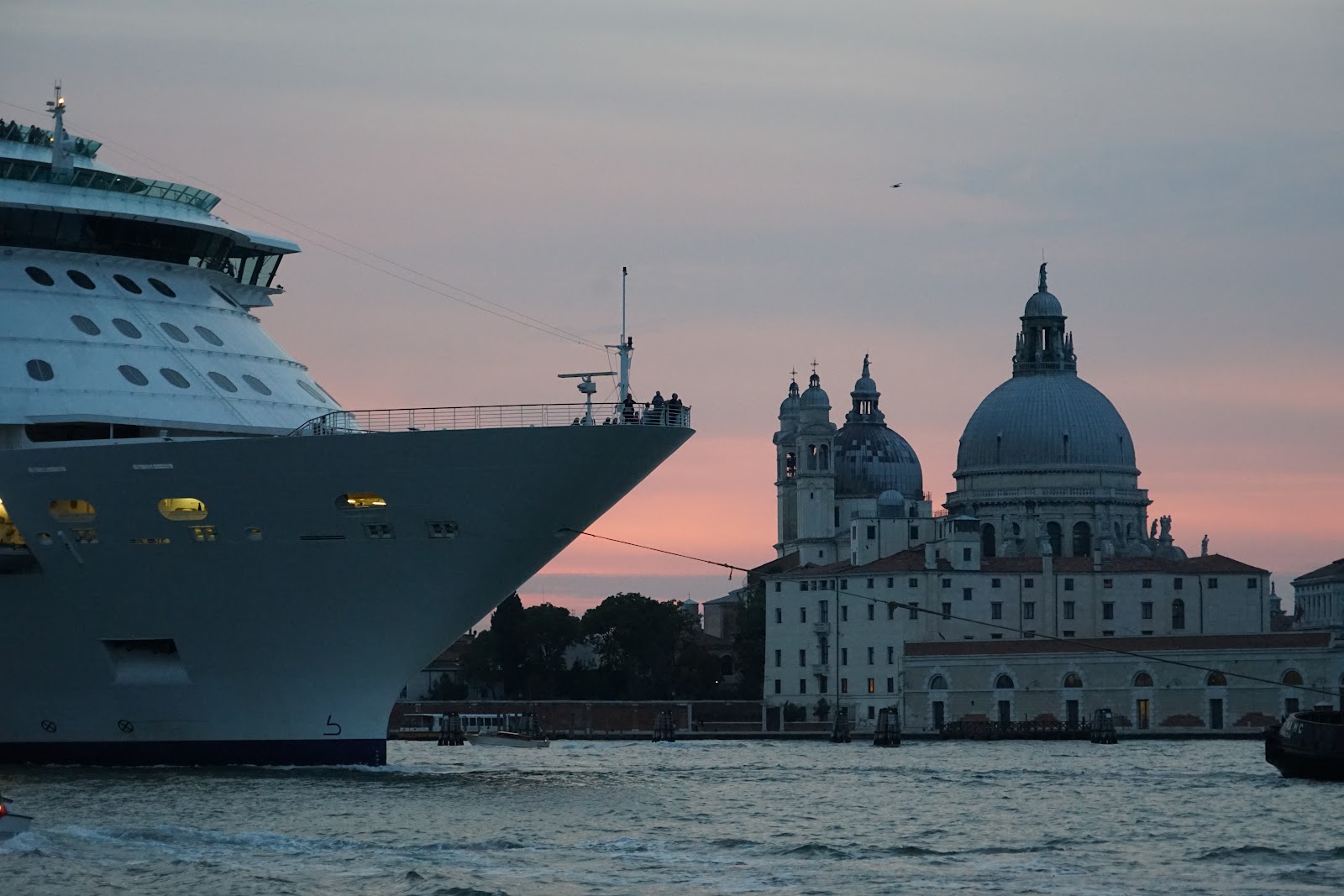

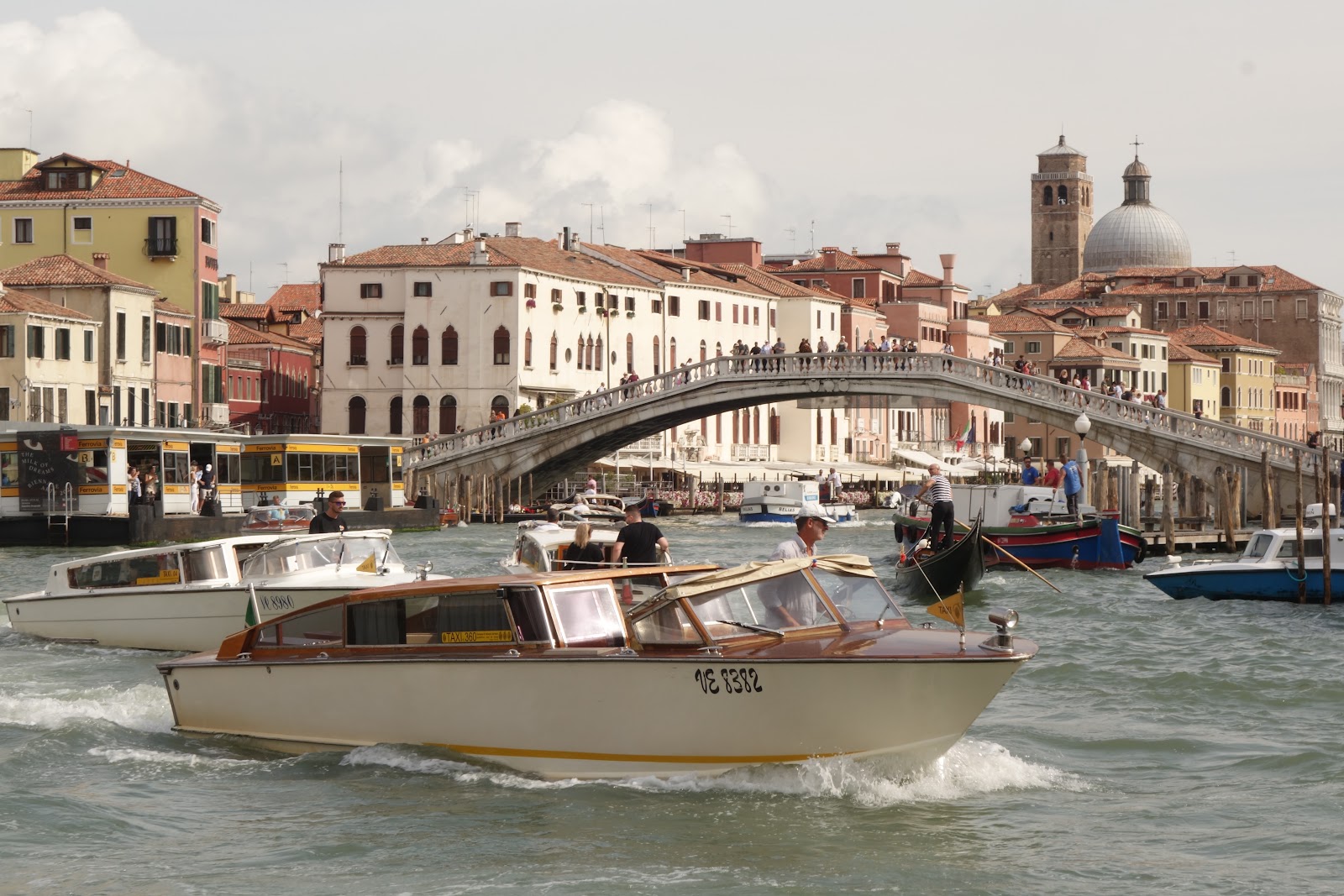
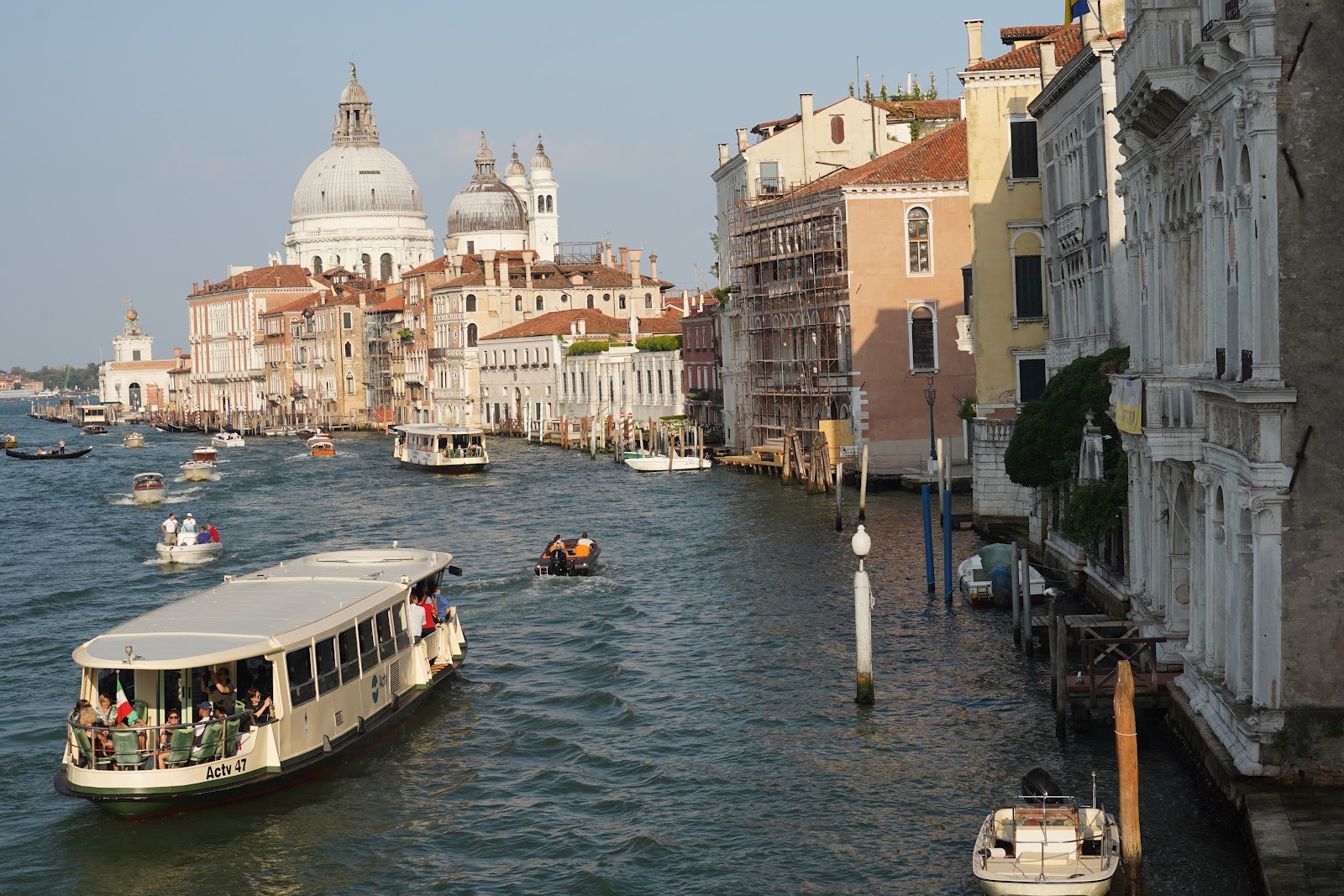



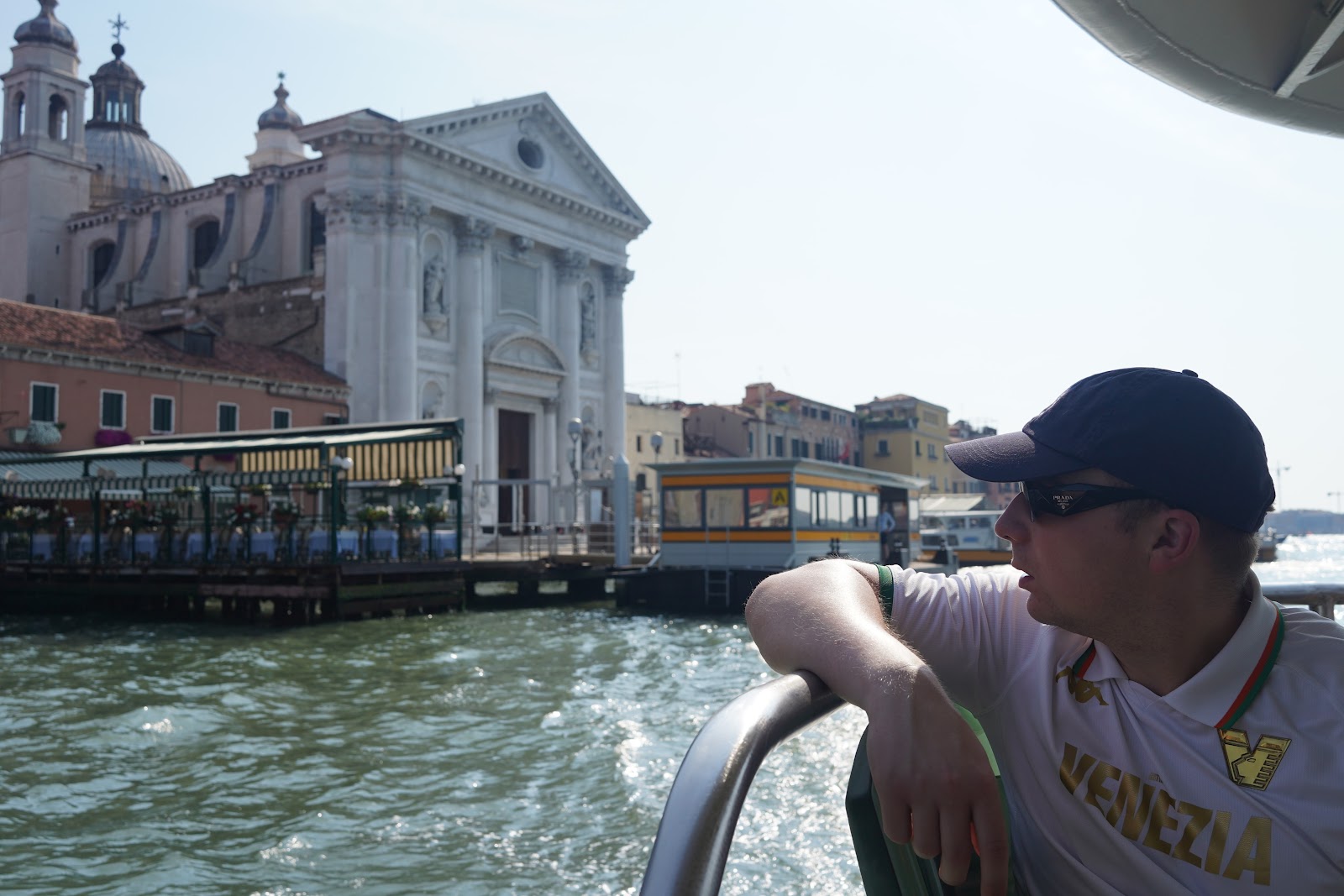

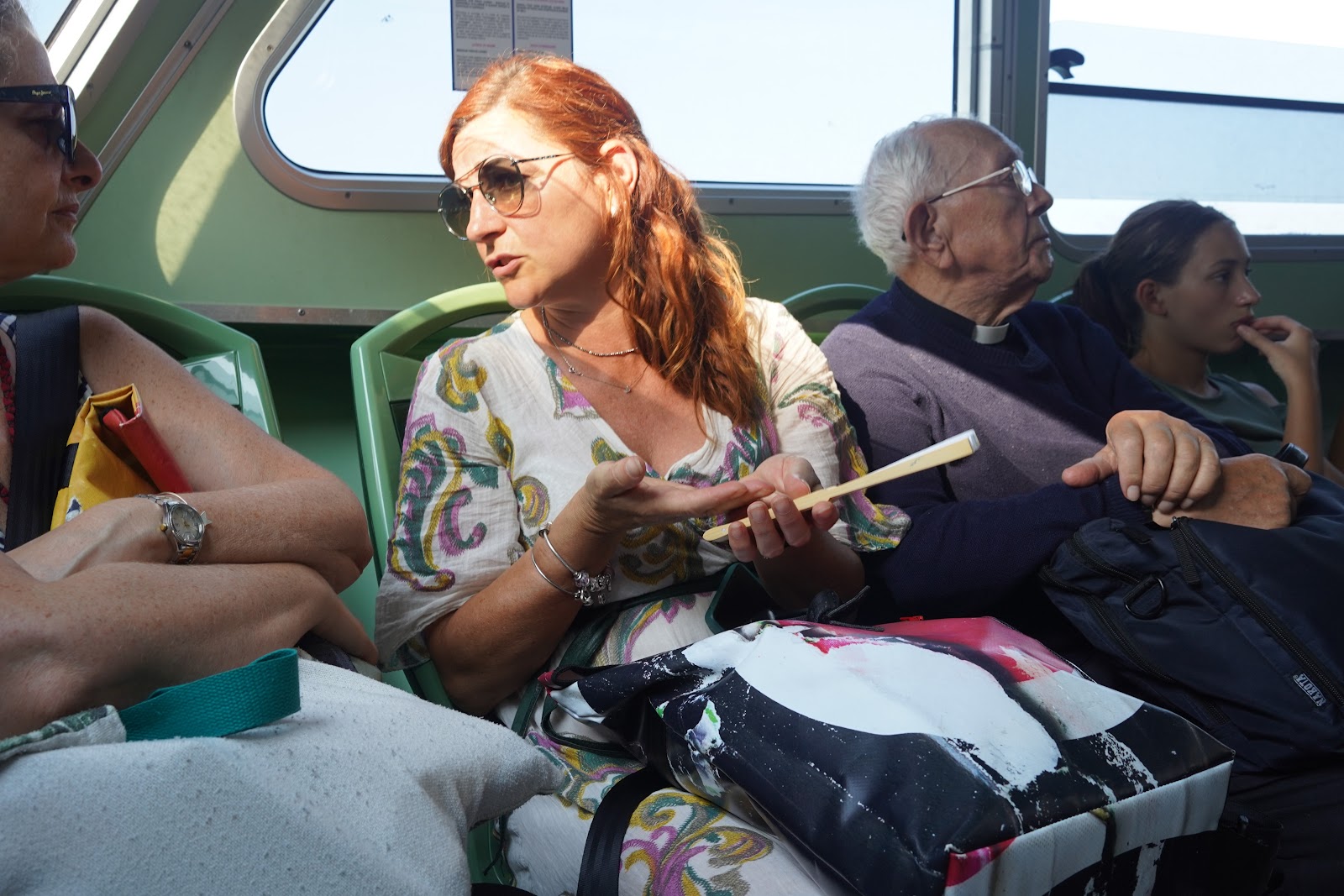

















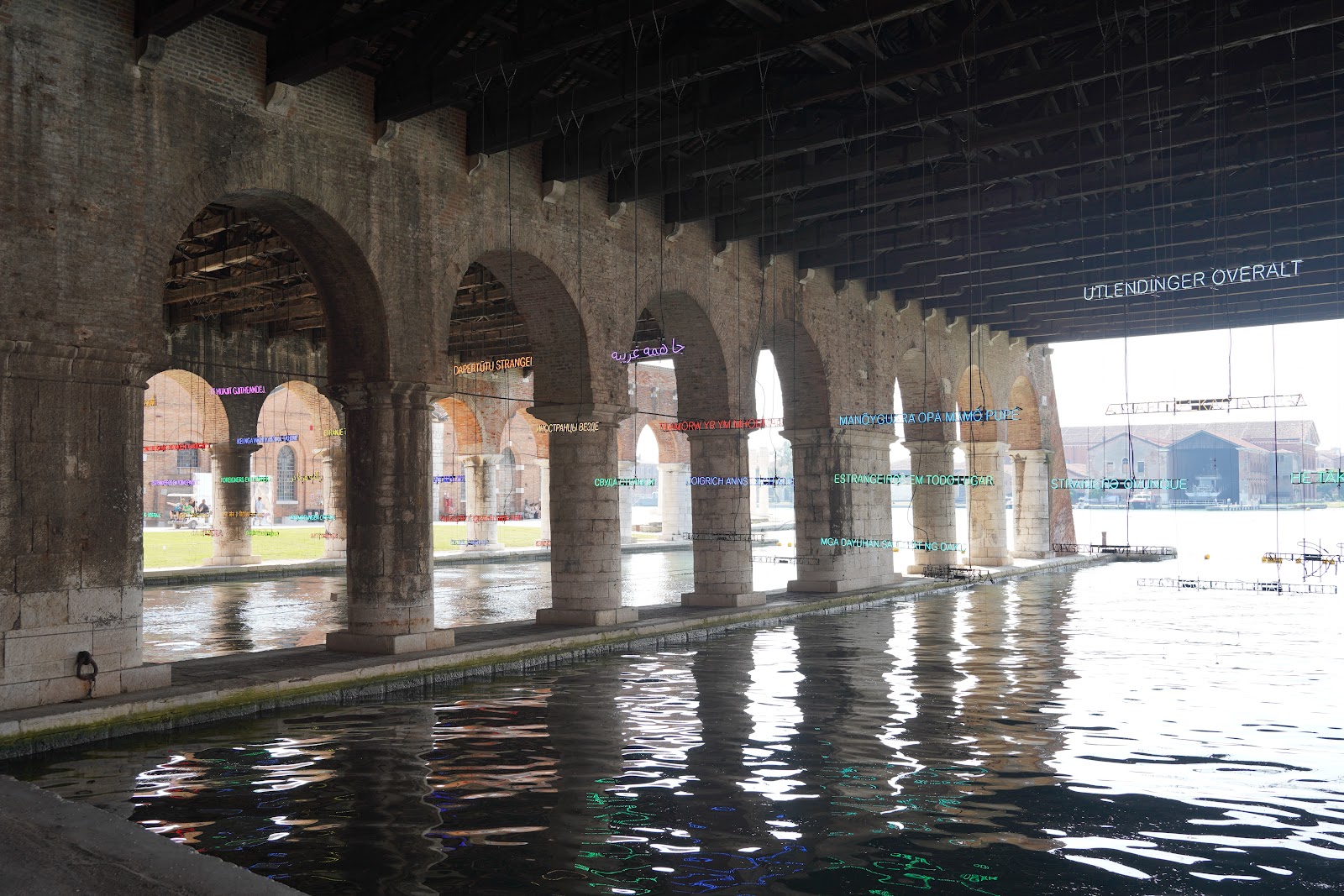
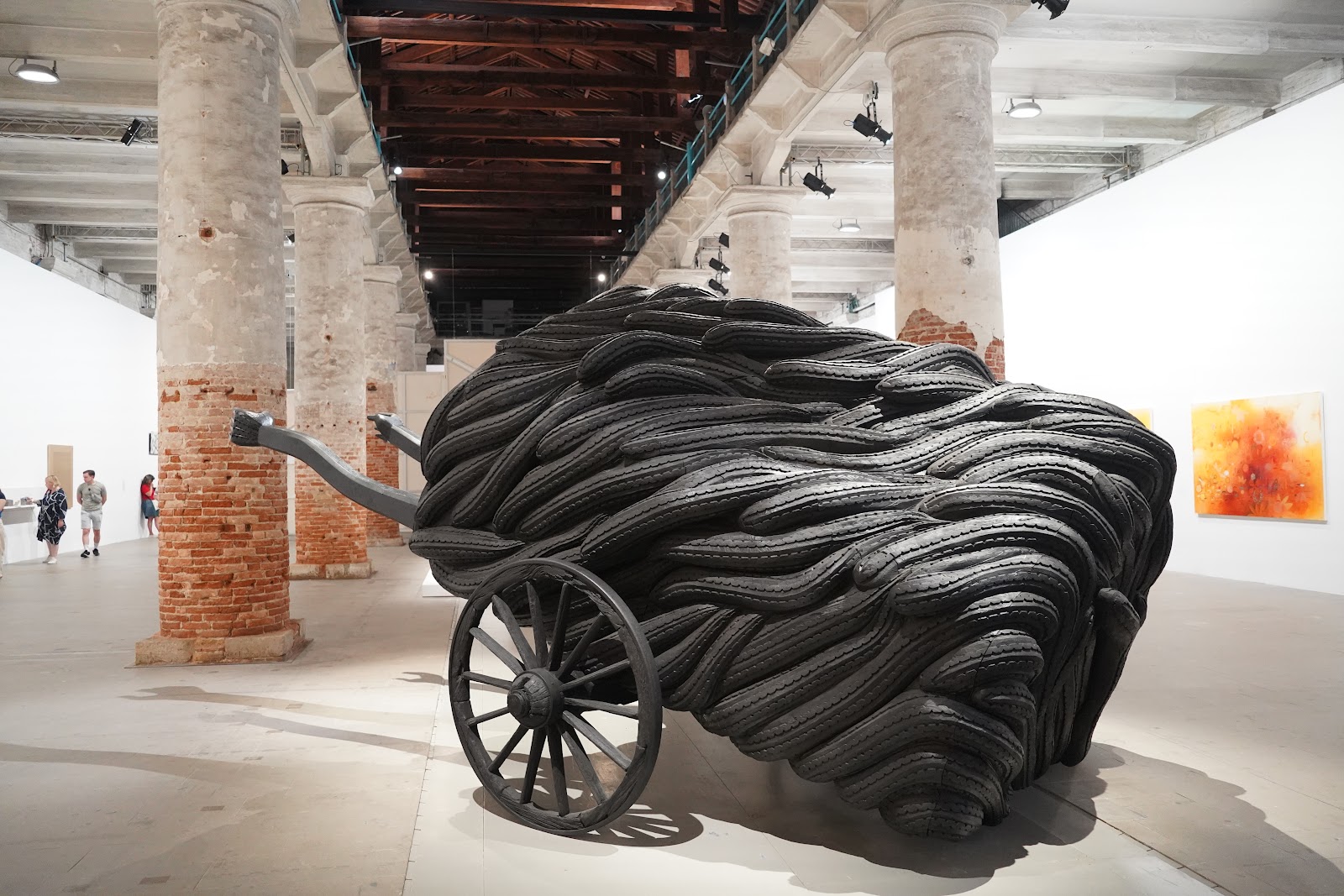















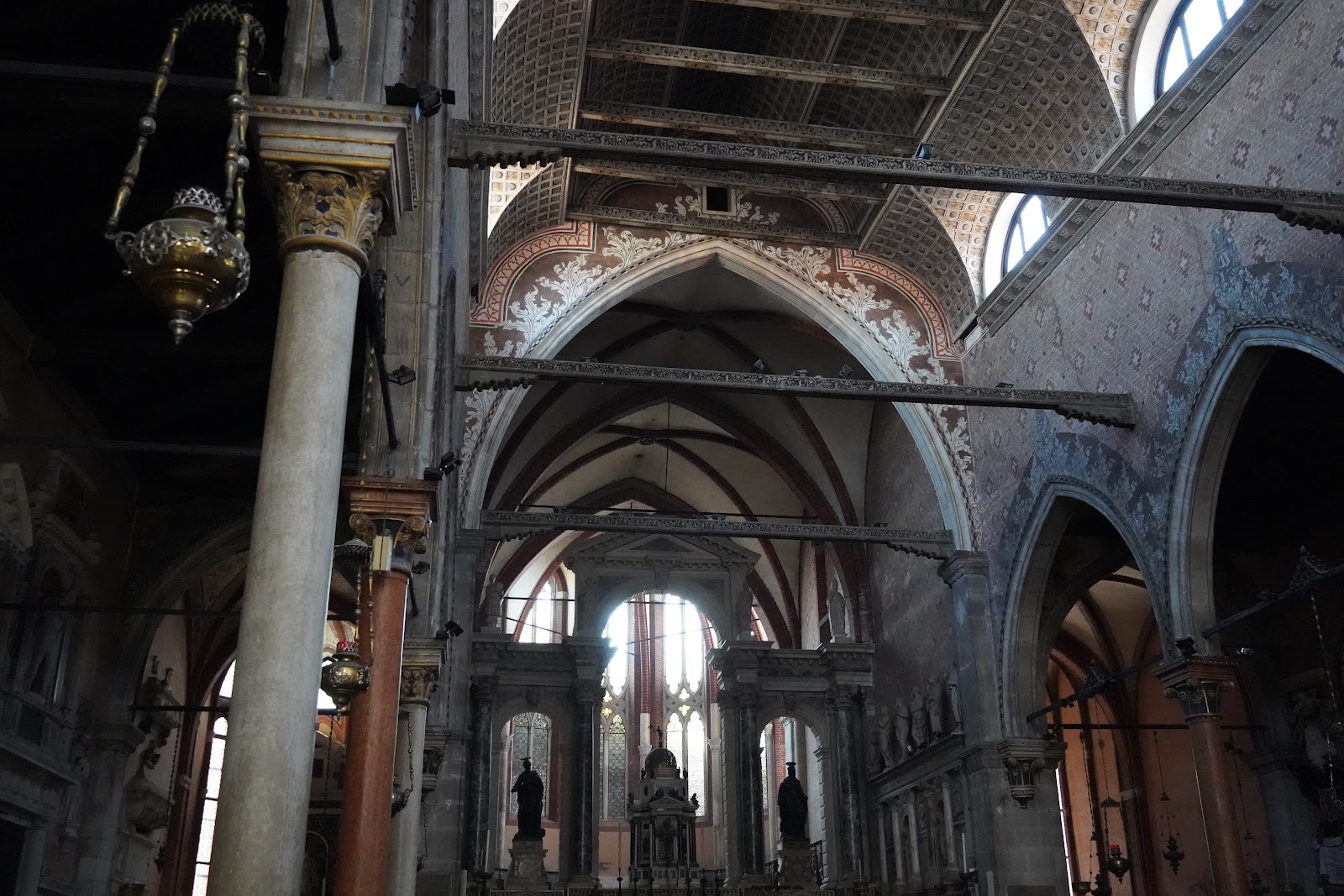














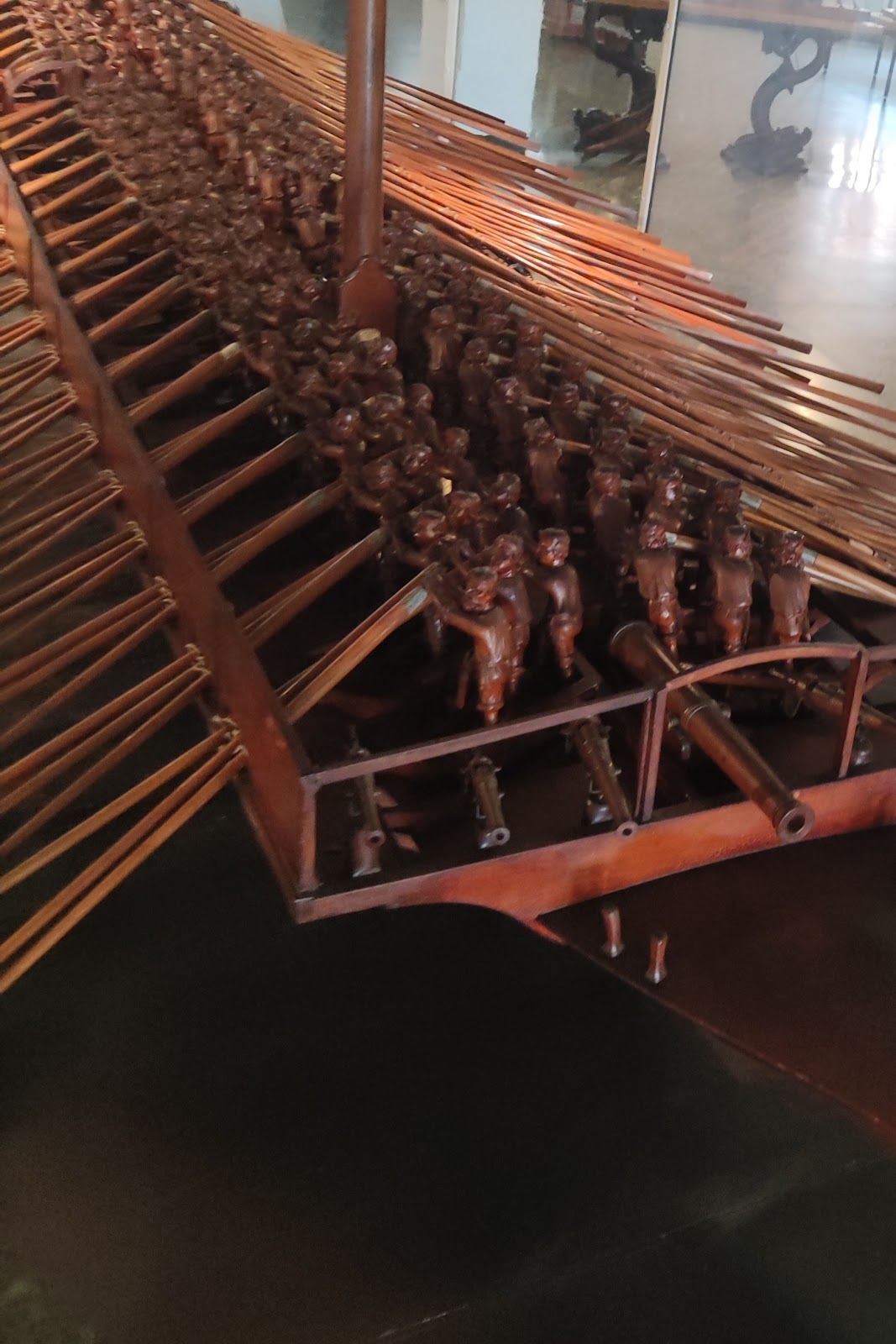
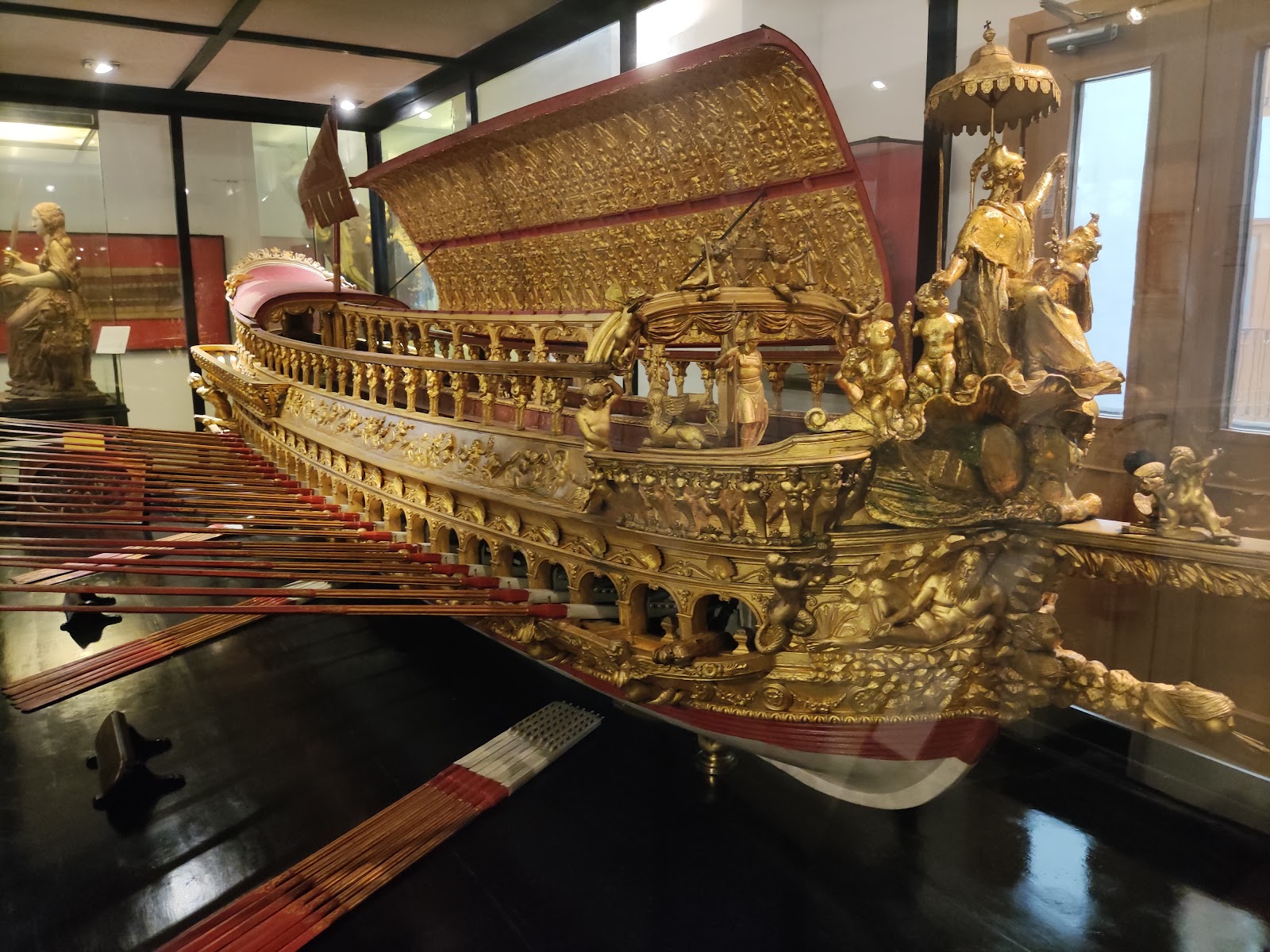


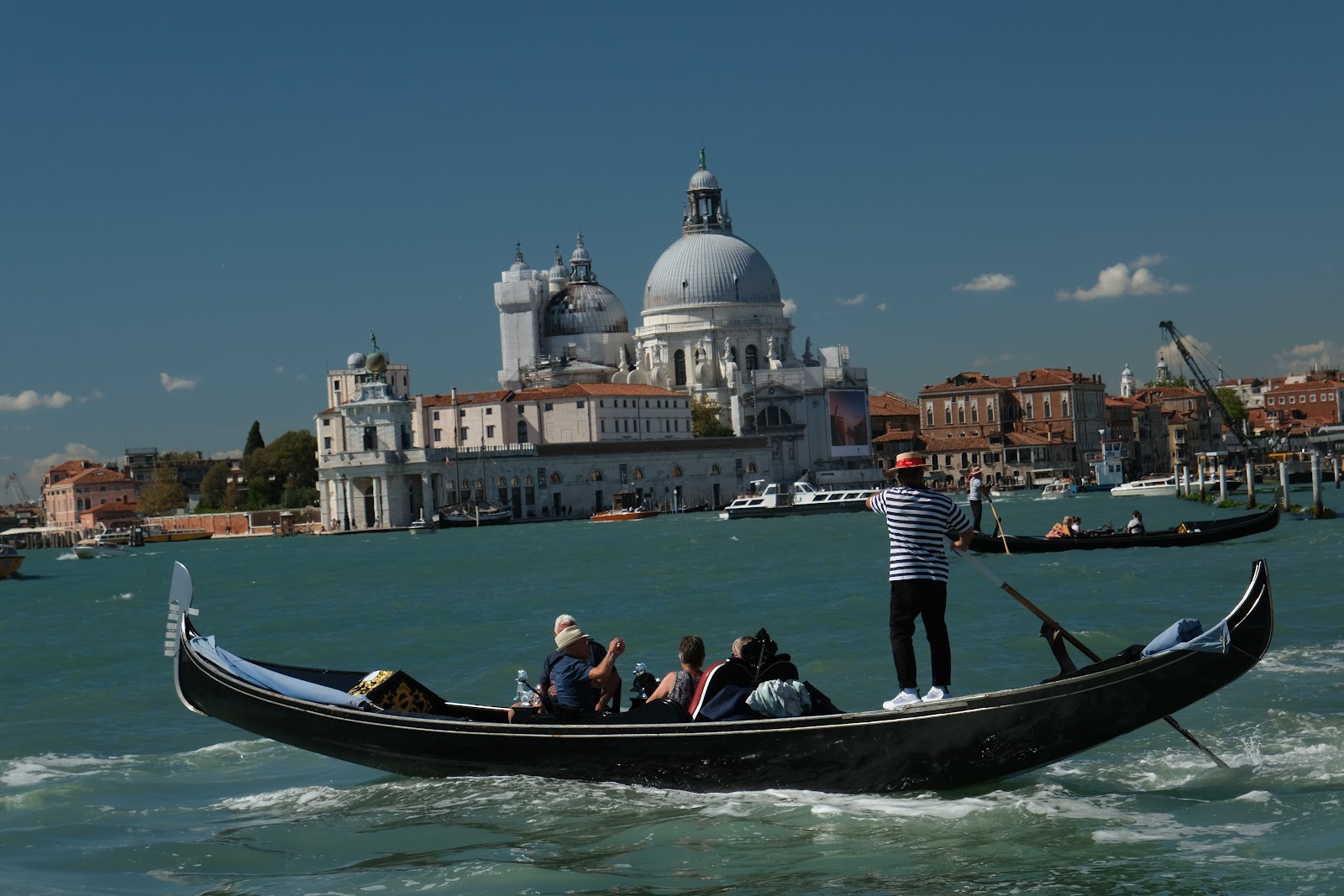

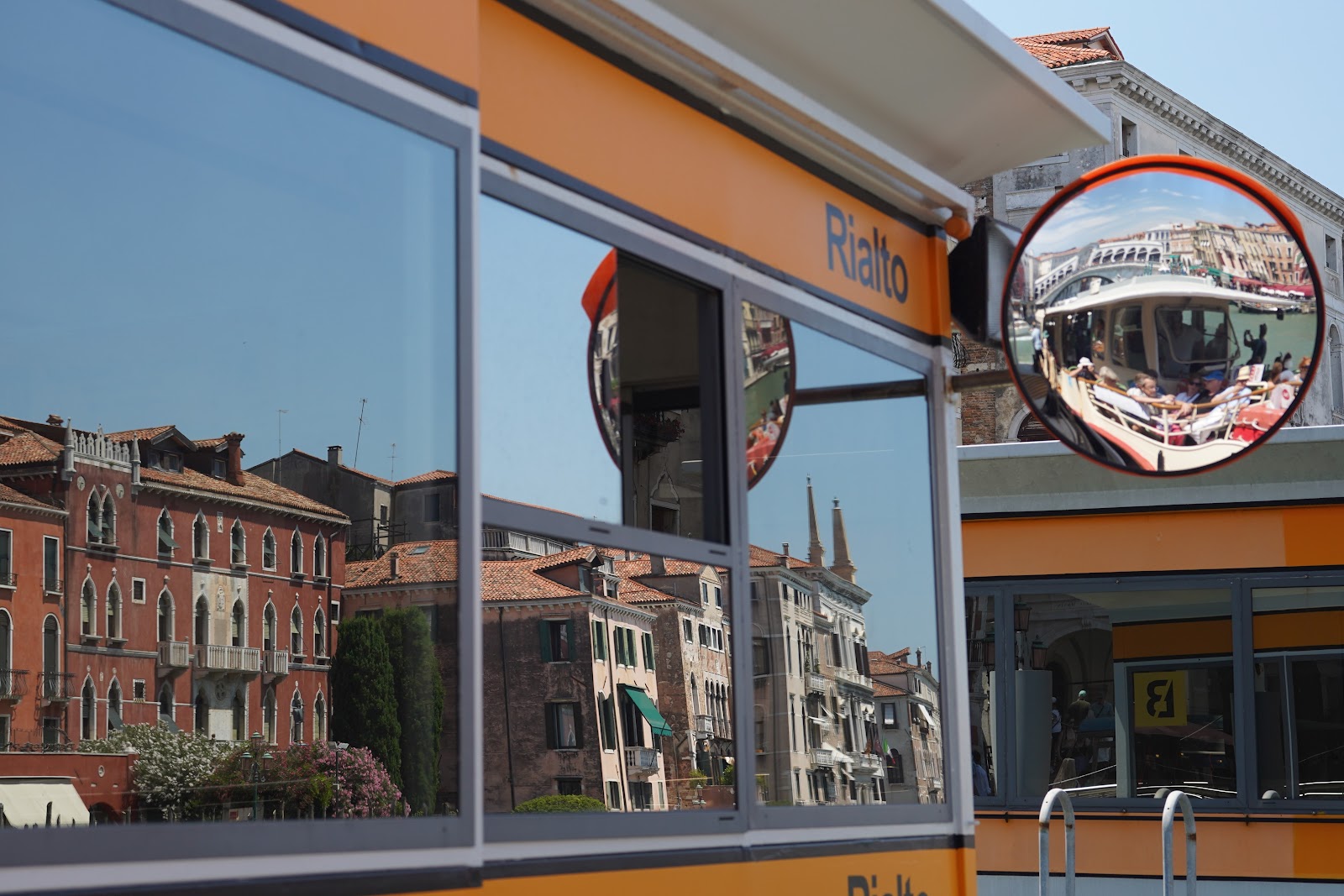

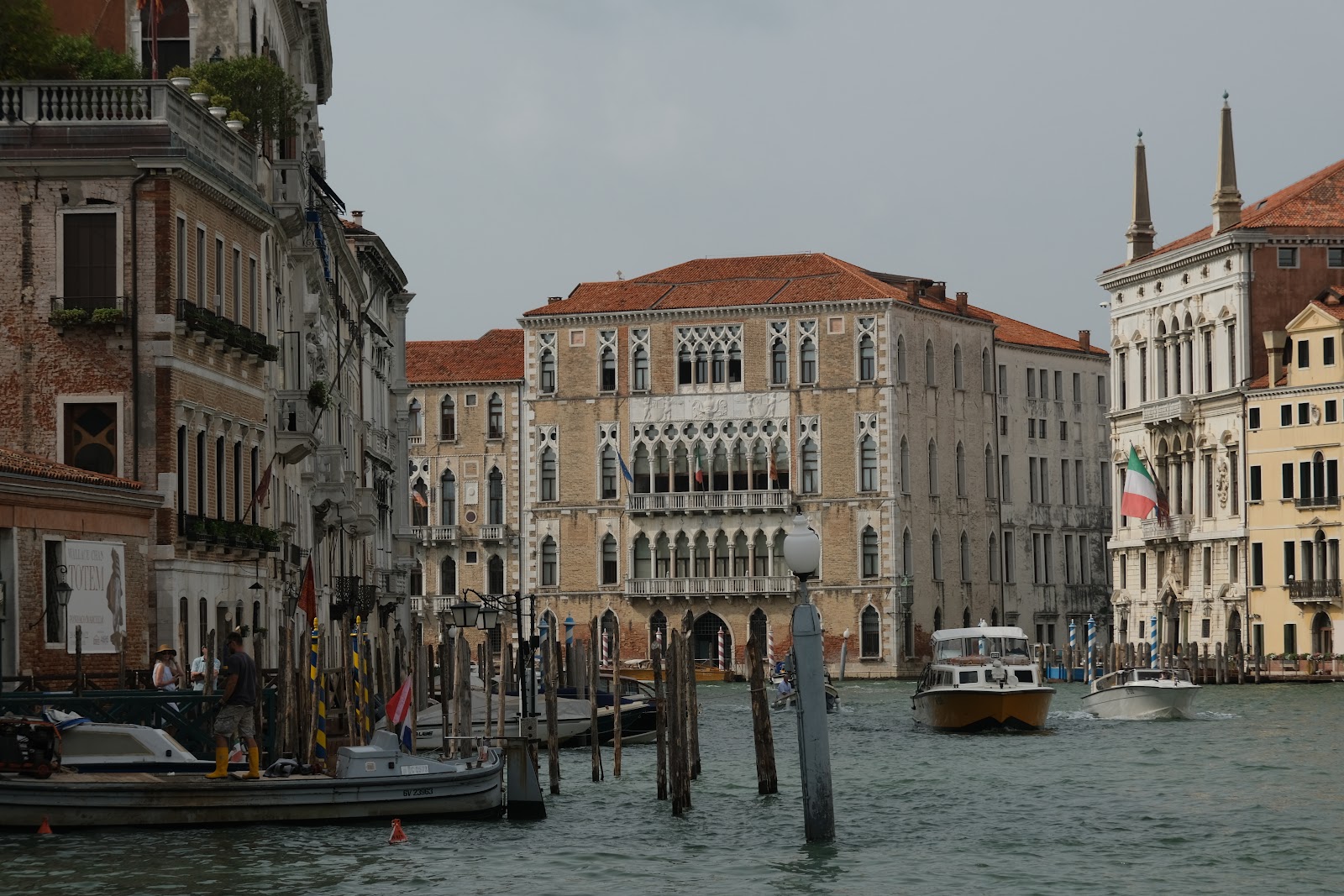



















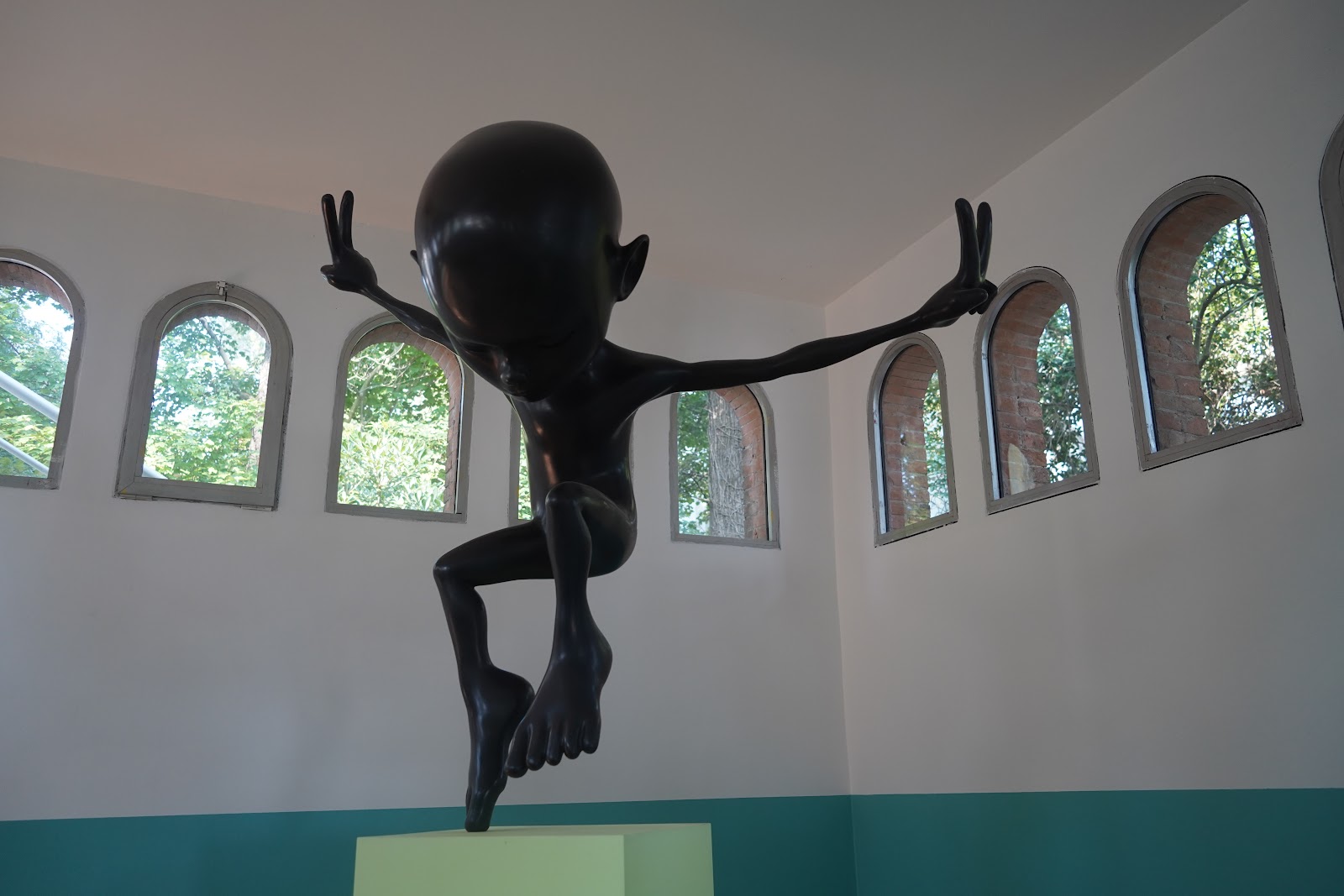



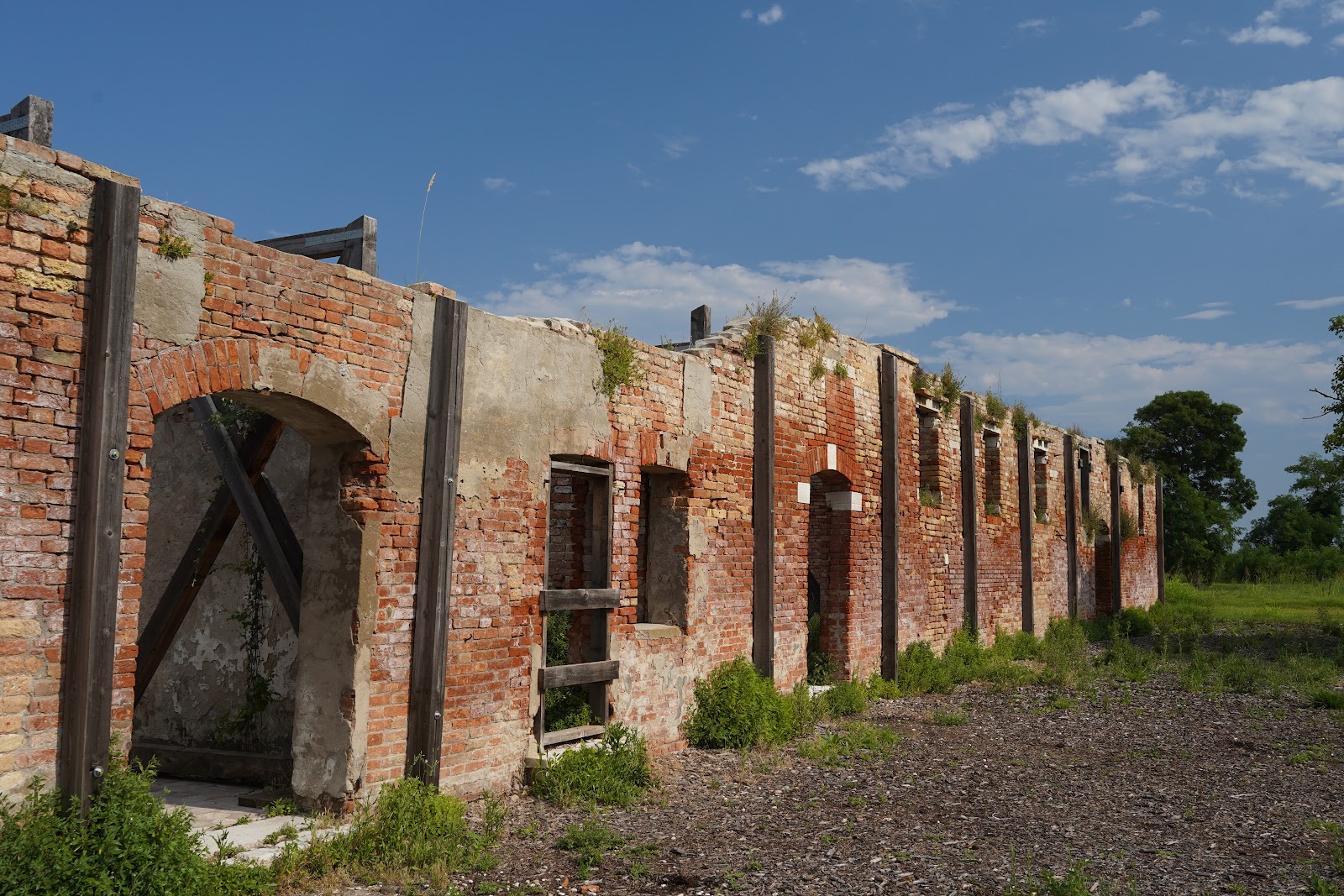





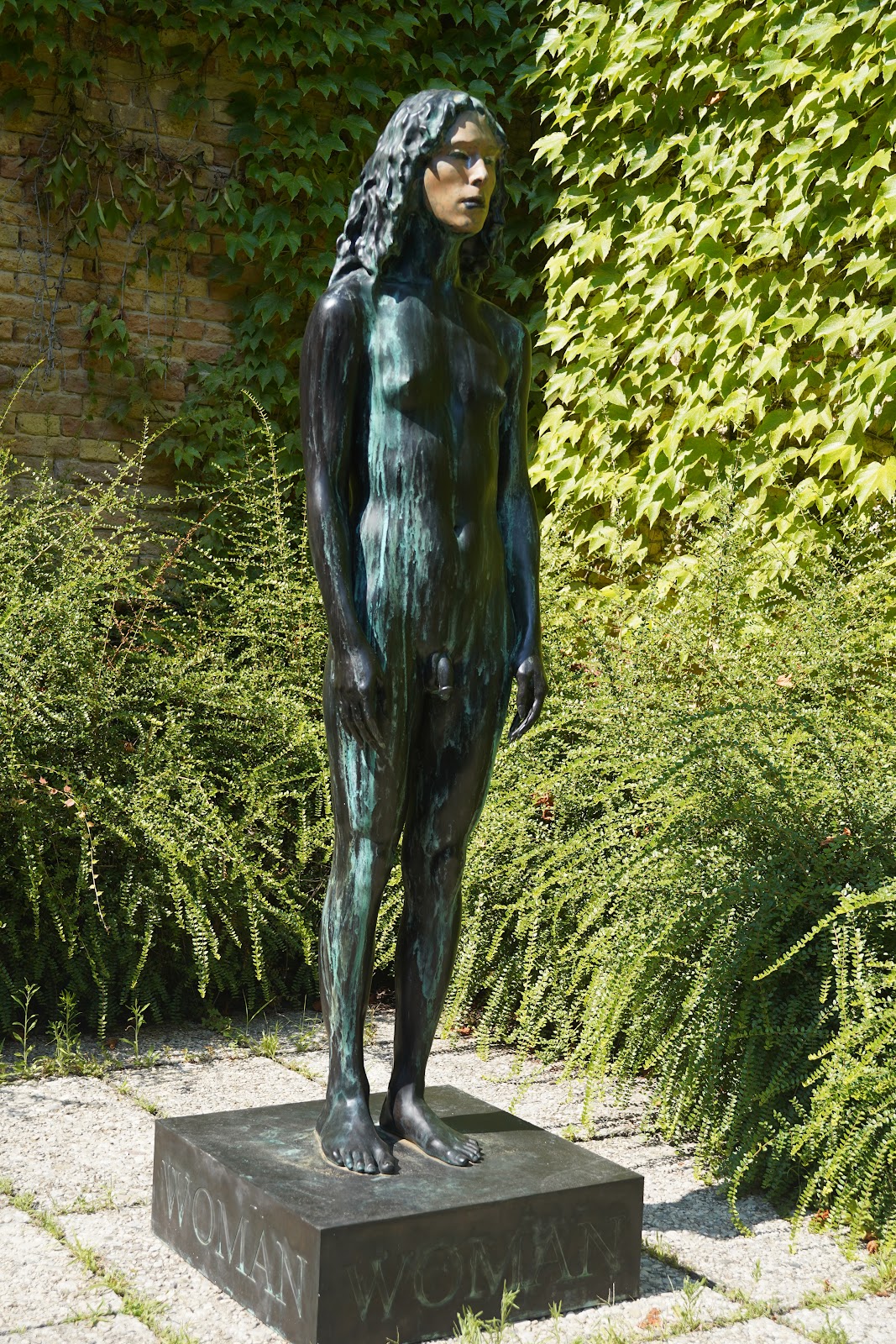










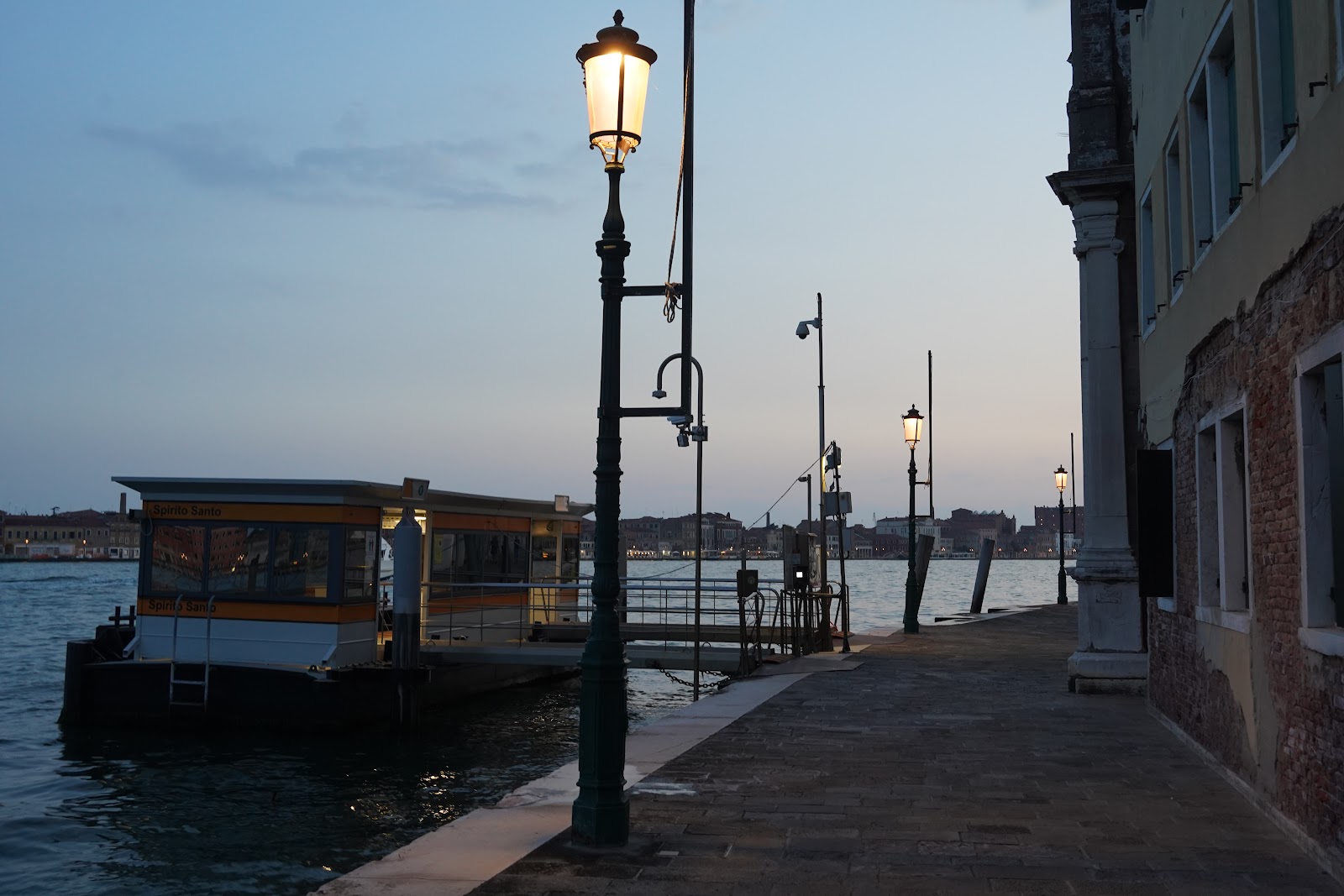

No comments:
Post a Comment